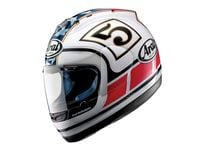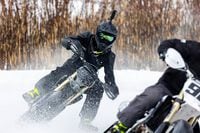Got a question for answers? Send it to mcmail@sorc.com
Cover Your Eyes
Q I've been riding for several years, and have always worn a full-face helmet. My question is, how much of an impact can a face shield take without shattering? I've been behind several dump trucks carrying dirt and stones and am wondering how well a visor would hold up to a significant blow? What happens to the material when it finally gives? Will it shatter into a zillion pieces?
Jeff Schmidt
Fort Belvoir, VA
A Most of us have taken a direct hit to the shield from some sort of animal, vegetable or mineral-based projectile with nothing worse than a nasty gouge in the plastic to show for it. To get a more empirical perspective, we posed your scenario to Dave Thom, a Senior Consultant specializing in protective headgear, safety and research at Collision and Injury Dynamics in El Segundo, California.
"The crash impact-absorbing capacity of helmets is reduced in front due to the large hole we need to see where we're going. That hole usually has an integrated face shield that will protect our faces from roost and debris kicked up by other vehicles. Most shields are made from polycarbonate-the same stuff fighter jet canopies are made of. It's very tough and doesn't shatter, etc. There are two common face shield standards: the Vehicle Equipment Safety Commission No. 8 (VESC-8 or V-8) and Snell. The most widely used one is VESC-8 because it's referenced in many states' mandatory eye protection laws. Shields for most helmets meet VESC-8, the Snell shield requirement or sometimes both. The VESC-8 test involves optical tests and a 1.56-ounce steel projectile with a conical point striking the shield at 20 mph, which must not penetrate. Cracking or piercing is allowed as long as the projectile doesn't actually pass through or remain lodged. The impact can't knock bits of shield material into the helmet, either. The Snell test doesn't involve any optical evaluation but does include a pellet-gun test that also prohibits the test projectile from entering the helmet. VESC-8 or V-8 will be molded into the shield in an out-of-the-way spot if qualified to this standard."













/cloudfront-us-east-1.images.arcpublishing.com/octane/3TIWWRV4JBBOLDVGRYECVVTA7Y.jpg)
/cloudfront-us-east-1.images.arcpublishing.com/octane/KIX5O23D5NAIBGFXBN3327DKZU.jpg)
/cloudfront-us-east-1.images.arcpublishing.com/octane/7GJYDUIPXRGMTMQKN6ONYOLBOU.jpg)
/cloudfront-us-east-1.images.arcpublishing.com/octane/MUQLOVLL2ZDGFH25ILABNBXKTI.jpg)
/cloudfront-us-east-1.images.arcpublishing.com/octane/TNOU5DNE2BC57MFPMGN2EIDXAM.jpg)
/cloudfront-us-east-1.images.arcpublishing.com/octane/GTCXACQGJ5HAPDTGWUQKDEH44E.jpg)
/cloudfront-us-east-1.images.arcpublishing.com/octane/S35YGSEMEZB4BLTDJTSZPF4GLA.jpg)
/cloudfront-us-east-1.images.arcpublishing.com/octane/5UOT6HPX2JFMRJAX6EH45AR4MQ.jpg)
/cloudfront-us-east-1.images.arcpublishing.com/octane/OKWOJWAKP5EP3OACCRRWPCIX2Q.jpg)
/cloudfront-us-east-1.images.arcpublishing.com/octane/2WF3SCE3NFBQXLDNJM7KMXA45E.jpg)
/cloudfront-us-east-1.images.arcpublishing.com/octane/G4MG6OUCJNBSHIS2MVVOTPX65E.jpg)
/cloudfront-us-east-1.images.arcpublishing.com/octane/IIGGWFOTOJGB7DB6DGBXCCMTDY.jpg)
/cloudfront-us-east-1.images.arcpublishing.com/octane/QSTCM6AVEZA5JJBUXNIQ3DSOF4.jpg)
/cloudfront-us-east-1.images.arcpublishing.com/octane/U4I7G625B5DMLF2DVIJDFZVV6M.jpg)
/cloudfront-us-east-1.images.arcpublishing.com/octane/B6XD6LS6IVCQPIU6HXDJSM3FHY.jpg)
/cloudfront-us-east-1.images.arcpublishing.com/octane/ICL63FEDDRDTTMINYICCEYGMDA.jpg)
/cloudfront-us-east-1.images.arcpublishing.com/octane/FCGZHQXRBZFLBAPC5SDIQLVF4I.jpg)
/cloudfront-us-east-1.images.arcpublishing.com/octane/WNOB6LDOIFFHJKPSVIWDYUGOPM.jpg)

/cloudfront-us-east-1.images.arcpublishing.com/octane/X33NU3E525ECRHXLNUJN2FTRKI.jpg)
/cloudfront-us-east-1.images.arcpublishing.com/octane/6KKT5NNL2JAVBOXMZYS5ZO76YA.jpg)
/cloudfront-us-east-1.images.arcpublishing.com/octane/J5RKG5O455GMPGQRF2OG6LRT7A.jpg)
/cloudfront-us-east-1.images.arcpublishing.com/octane/GX2CIZKQVRH2TATDM26KFG2DAE.jpg)